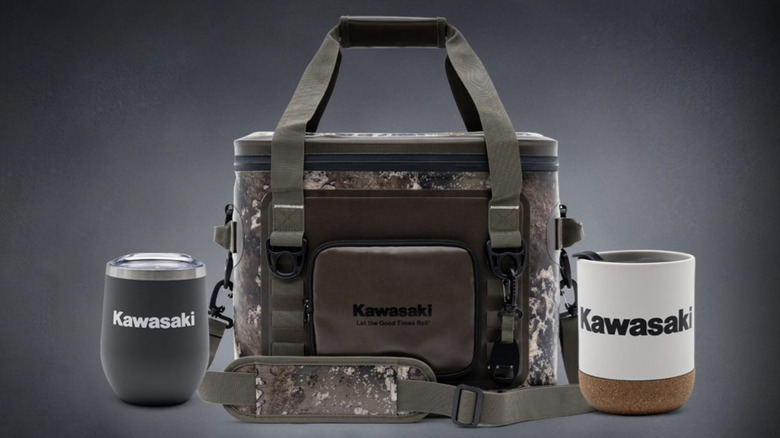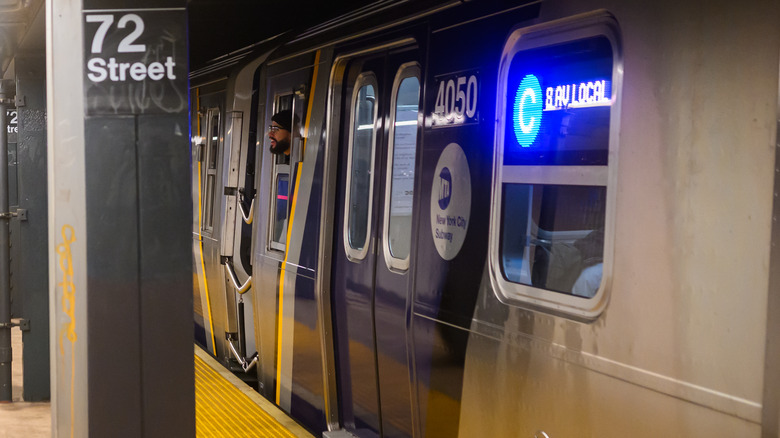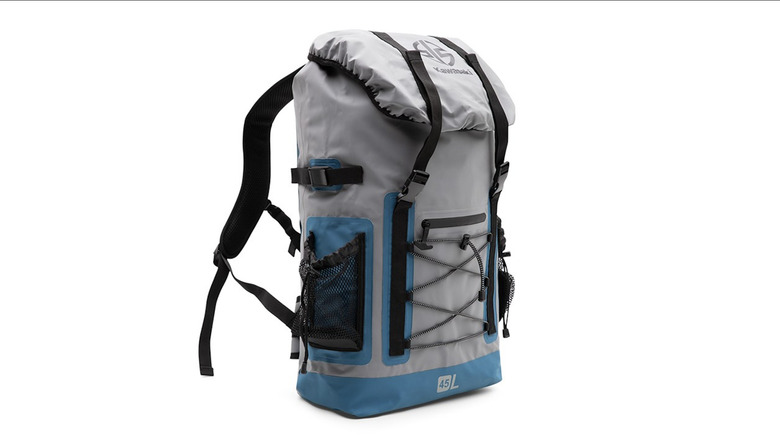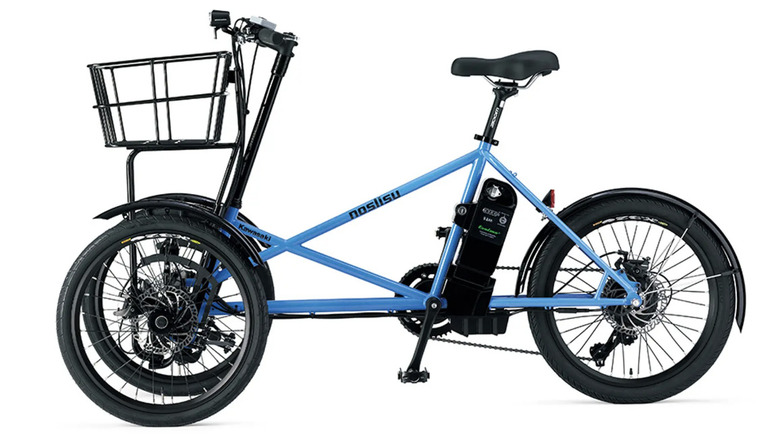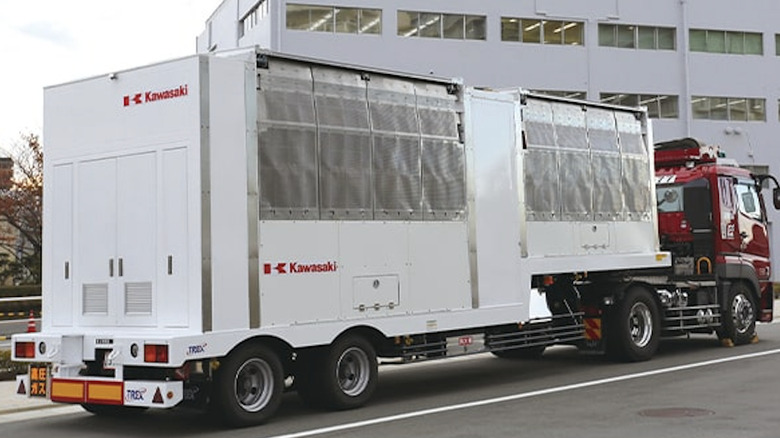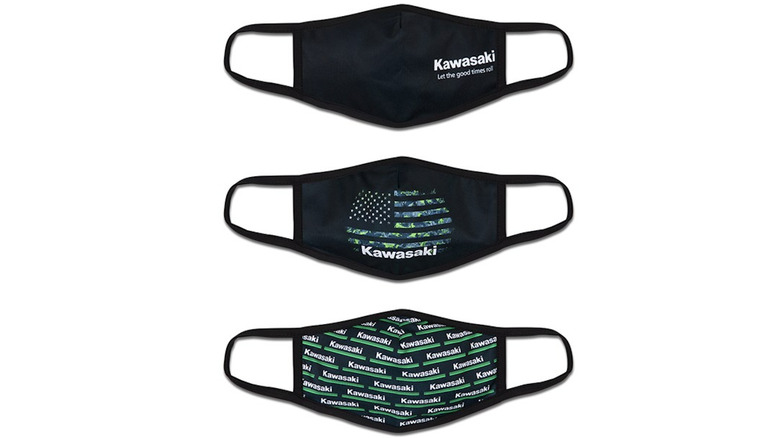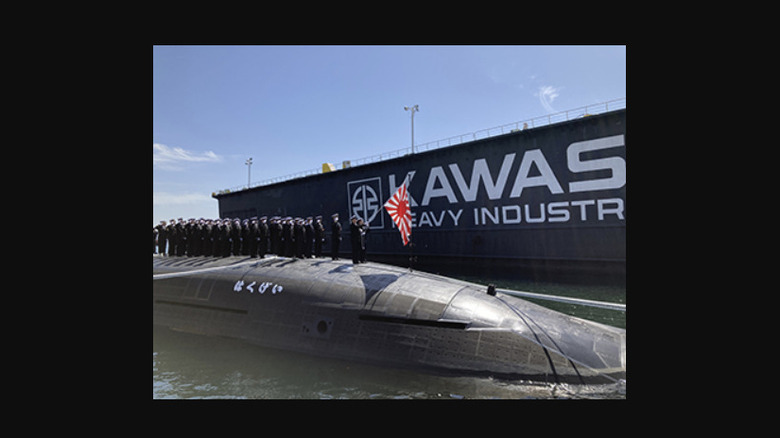6 Products You'll Be Surprised To Know Kawasaki Makes
When you think of motorcycles, there are probably a couple of brand names that come immediately to mind — including Harley-Davidson and Kawasaki. Kawasaki has been making motorcycles since the 1960s and manufacturing them around the world, including in Japan and Lincoln, Nebraska — so it's not surprising the company is so closely associated with the vehicle.
Kawasaki is a very large company, though, and it makes a wide range of vehicles, equipment, and products, including those that are very different from motorcycles. In addition to the two-wheeled bikes, Kawasaki makes equipment for air, marine, and rail travel, if not the vehicles themselves. For example, while Boeing makes the unique 787 Dreamliner passenger jet, Kawasaki is responsible for manufacturing its landing gear, as well as the forward section of its fuselage and the fixed section of its wing's trailing edge.
Additionally, Kawasaki makes all sorts of industrial equipment, including in the energy industry, and — importantly — is contributing to the development of cleaner energy solutions, as with its wet biomass fermentation system and hydrogen storage equipment. Kawasaki also makes and sells much smaller products, such as equipment and apparel, to go along with its leisure and off-road vehicles. This includes must-have Kawasaki motorcycle accessories — like tank bags and fire extinguishers — as well as merchandise like hats, t-shirts, and hoodies. Here is a closer look at six different products you'll be surprised to know Kawasaki makes.
Rail Cars
Kawasaki has actually been making rail cars and train equipment far longer than it has motorcycles and bike engines. In fact, the first Kawasaki rail cars rolled off the assembly line and onto the tracks well over 100 years ago, in 1906. Just a few years later, the company made its first steam locomotive, before switching to electric trains in the 1950s. While many of Kawasaki's trains and rail cars can be found in Japan, they are also found elsewhere around the world, including as part of New York City's famed subway system, which provides transportation for over 3 million riders per day. Kawasaki began providing cars for the transit system in 1982.
As the city's population grows and public transit becomes more important than ever, New York has been trying to find ways to increase ridership without building new tunnels or tracks. In 2023, New York's MTA showcased the new R211 subway cars manufactured by Kawasaki, which are the first in the system's history to connect a train's cars with accordion-like walls as part of an open gangway design, allowing passengers to move freely between cars and make for a more efficient people mover. The doors are 8 inches wider than those on existing NYC subway cars, which will speed up boarding and disembarking times and increase passenger flow.
The new R211 subway cars made by Kawasaki also sport more modern features, such as security cameras, additional accessible seating, and brighter lighting and signage, including digital displays that can provide more detailed station-specific information. Even if you've never been on a motorcycle before, if you're visiting or living in New York City and riding the subway, there's a good chance you've ridden a Kawasaki.
Backpacks
Many of Kawasaki's customers include off-road enthusiasts who ride the brand's bikes and ATVs, so the company makes other apparel and equipment to cater to this demographic. That includes backpacks, which can be just as useful for off-roaders as for anyone else who needs to carry stuff around day-to-day, whether it's hiking gear or an office laptop.
Kawasaki's Knifelake Rolltop Dry Pack has a 45-liter capacity and is perfect for rugged outdoor use, as the PVC tarpaulin bag is equipped with waterproof welded seams and waterproof material. It gives you plenty of storage options with two mesh side pockets and an exterior waterproof pocket with a toggled zipper, and it's easy to access the main compartment via a roll down top with buckles. It's also comfortable to carry on long hauls thanks to its padded back and adjustable padded shoulder straps.
If you need a smaller (or more affordable) backpack, another option is Kawasaki's Slimming Backpack, which is 10 x 17 x 3 inches and has a deep storage compartment despite its slender design. In line with the brand's aesthetic, the commuter-style backpack is dark gray with green zippers and has the Kawasaki logo on its pull zippers and main compartment. It includes an inside pocket, two mesh pockets on the side, and three additional outside pockets, giving you plenty of storage options. Its adjustable straps and padded back also make it comfortable to wear. Offered through Kawasaki's online store, either backpack can be purchased and delivered to you within a week.
Noslisu E-Trike
Kawasaki is most closely associated with its motorcycles and dirt bikes, but there's another form of transportation the brand has recently decided to start making — the Nosilsu e-trike. The concept originally spawned from an intracompany brainstorming program conducted in 2020. The idea behind the Noslisu — as with other e-trikes like Sinclair's IRIS — is to expand personal transportation to a wider range of the population that can't utilize a motorcycle — such as older folks and delivery drivers — as well as provide cleaner, electric and manual-powered transportation in light of climate change and the push for more sustainable transportation.
The third wheel of the e-trike provides more balance than e-scooters and bicycles and offers a more comfortable ride. It comes in both fully electric and electric-assist models, with the latter allowing you to use traditional bicycle pedals for propulsion when you want. Combining compact mobility technology Kawasaki has honed by developing motorcycles over the years with the highly stable design of its two front wheels and third rear wheel, the e-trike uses synchronized steering and a tilting mechanism to provide a smooth and safe ride.
The Noslisu provides a low-positioned cargo rack between the front two wheels, but an additional model is also available that's designed with delivery drivers in mind. It includes even more capacity that can carry goods while maintaining the balance of the vehicle. This also makes it great for personal use if you want to take it grocery shopping or run other errands. However, you'll need a driver's license to operate the fully electric model, which is powered by a 500-watt rear hub motor and has a range of around 30 miles per charge. It's not yet available in the U.S., though, you can buy one in Japan for a little over $3,000 (USD).
Compressed Hydrogen Trailer
In addition to Kawasaki expanding its lineup with electric motorcycles and e-trikes, the company has also been investing in another source of clean energy — hydrogen power. High-tech engines can use dual-sided hydrogen fuel cells — while traditional EVs have many advantages over the current technology, hydrogen power is attractive because cars can refuel faster and have longer range. There is still a chance that hydrogen-powered vehicles become as much a part of the commercial market as EVs, and if that happens, Kawasaki is ready to facilitate the movement (and profit from it).
Hydrogen power needs its own form of infrastructure, just as gas-powered and electric vehicles do. The company is already manufacturing several ways to transport hydrogen fuel, including building large-scale liquefied hydrogen-carrying ships, as well as trucks that resemble traditional fuel trucks, except they use Kawasaki-developed insulation technology that allows them to transport liquified hydrogen at -253 degrees Celsius.
Similarly, another product made by Kawasaki is a trailer that can carry and transport compressed gaseous hydrogen. These trailers make it easy to transport the clean fuel source from hydrogen production facilities to offsite hydrogen fueling stations (just as gasoline is transported to gas stations), as well as remain stored there in the trailer itself where it can then be supplied to hydrogen-powered vehicles.
Face Masks
Back in 2020 and 2021, it seemed like just about everyone was making face masks — and with good cause. As we sought to personalize our masks like we would any other form of apparel, it wouldn't be strange to see people on the street wearing branded masks, perhaps with the logo of their favorite sports team, for example. Kawasaki sells a three-pack of three different branded face masks for less than $13. (However, they're no longer sold directly online, and you'll have better luck finding them at your local Kawasaki dealership.)
One is a plain black mask with the Kawasaki logo and "Let the good times roll" written in white. Another is a black mask with a repeated Kawasaki green line logo, while the third is a black mask with a green and blue camouflage American flag and the brand name printed underneath. The Camo Flag and Green Line Repeater masks are both 100% sublimated polyester, while the Good Times mask is screen-printed 100% cotton.
While these cloth masks aren't as ideal for preventing COVID-19 and other airborne infectious diseases as medical grade options like N-95 masks, KN95 masks, and P100 respirators, they're certainly better than nothing — and can come in very useful if there's another surge in COVID cases or another inevitable infectious epidemic. However, you don't have to wait for such an unfortunate event to use these Kawasaki face masks, as they're also great for keeping dust and debris out of your mouth and nose while dirt biking and off-roading — which, if you're a Kawasaki fan, you might very well be doing in the near future.
Submarines
Believe it or not, Kawasaki also makes submarines, as well as other ships such as deep sea research vessels that contribute "to the modernization of maritime safety and oceanographic research." It even makes a deep submergence rescue vehicle (DSRV). To date, the company has manufactured over 80 submarines. In 2023, Kawasaki delivered its second Taigei-class submarine — the Hakugei — to the Japan Ministry of Defense (MOD). It was the 30th built at the Kawasaki Kobe Shipyard since World War II. The Hakugei took over two years to build and is 84 meters long and 10.4 meters tall — at its widest point, the sub is just 9.1 meters wide. It displaces 3,000 tons.
Powered by two Kawasaki 12V 25/25 SB-type diesel engines and an electric propulsion motor, the submarine is made with high-strength steel for its pressure hull. Its lithium-ion battery systems have been optimized for increased underwater endurance. As one of the newest submarines to hit the open seas, the Hakugei is packed with modern technology, including various automated systems, enhanced safety measures, improved surveillance capabilities using high-performance sonar, and increased stealth capabilities. As Japan's navy officially put an end to only using all-male submarine crews in 2018, several facilities have also been incorporated into the Hakugei for female crew.
